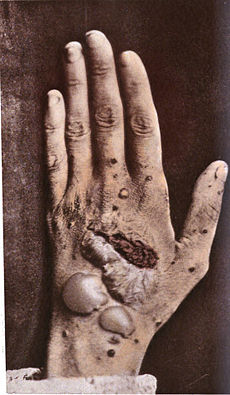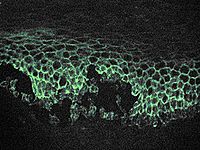- Pemphigus
-
Pemphigus Classification and external resources 
ICD-10 L10 ICD-9 694.4 OMIM 169600 Benign Chronic ~
169610 ~ Vulgaris, FamilialDiseasesDB 9764 31179 33489 MedlinePlus 000882 eMedicine derm/317
derm/318 ~ foliaceus
derm/314 Drug-induced ~
derm/543 ~ herpetiformis
derm/315 ~ IgA
derm/319 ~ Vulgaris
derm/535 ~Paraneoplastic
derm/150 Benign ~
(Hailey-Hailey Disease)MeSH D010392  Microscopic image of direct immunofluorescence using an anti-IgG antibody. The tissue is skin from a patient with Pemphigus vulgaris. Note the intercellular IgG deposits in the epidermis and the early intraepidermal vesicle (dermatology) caused by acantholysis.
Microscopic image of direct immunofluorescence using an anti-IgG antibody. The tissue is skin from a patient with Pemphigus vulgaris. Note the intercellular IgG deposits in the epidermis and the early intraepidermal vesicle (dermatology) caused by acantholysis.
Pemphigus is a rare group of blistering autoimmune diseases that affect the skin and mucous membranes.[1]
In pemphigus, autoantibodies form against desmoglein. Desmoglein forms the "glue" that attaches adjacent epidermal cells via attachment points called desmosomes. When autoantibodies attack desmogleins, the cells become separated from each other and the epidermis becomes "unglued", a phenomenon called acantholysis. This causes blisters that slough off and turn into sores. In some cases, these blisters can cover a significant area of the skin.[2]
Originally, the cause of this disease was unknown, and "pemphigus" was used to refer to any blistering disease of the skin and mucosa. In 1964, a historic paper that changed the understanding of pemphigus was published.[3][4] In 1971, an article investigating the autoimmune nature of this disease was published.[5][6]
Contents
Types
There are three types of pemphigus which vary in severity: pemphigus vulgaris, pemphigus foliaceus, and paraneoplastic pemphigus.
- The most common form of the disorder is pemphigus vulgaris (PV - ICD-10 L10.0). It occurs when antibodies attack Desmoglein 3. Sores often originate in the mouth, making eating difficult and uncomfortable. Although pemphigus vulgaris may occur at any age, it is most common among people between the ages of 40 and 60. It is more frequent among Ashkenazi Jews. Rarely, it is associated with myasthenia gravis. Nail disease may be the only finding and has prognostic value in management.
- Pemphigus foliaceus (PF) is the least severe of the three varieties. Desmoglein 1, the protein that is destroyed by the autoantibody, is only found in the top dry layer of the skin. PF is characterized by crusty sores that often begin on the scalp, and may move to the chest, back, and face. Mouth sores do not occur. It is not as painful as pemphigus vulgaris, and is often mis-diagnosed as dermatitis or eczema.
- The least common and most severe type of pemphigus is paraneoplastic pemphigus (PNP). This disorder is a complication of cancer, usually lymphoma and Castleman's disease. It may precede the diagnosis of the tumor. Painful sores appear on the mouth, lips, and the esophagus. In this variety of pemphigus, the disease process often involves the lungs, causing bronchiolitis obliterans (constrictive bronchiolitis). Complete removal and/or cure of the tumor may improve the skin disease, but lung damage is generally irreversible .
Note that Hailey-Hailey disease, also called familial benign pemphigus, is an inherited (genetic) skin disease, not an autoimmune disease. It is therefore not considered part of the Pemphigus group of diseases.[7]
Classification
Pemphigus is a group of autoimmune blistering diseases that may be classified into the following types[8]:
-
- Pemphigus vulgaris, of which there several forms:
-
- Pemphigus vegetans
-
- Pemphigus vegetans of Hallopeau
- Pemphigus vegetans of Neumann
- Pemphigus foliaceus, of which there several forms:
-
- Pemphigus erythematosus
- Endemic pemphigus
- Paraneoplastic pemphigus
- IgA pemphigus, of which there several forms:
-
- Subcorneal pustular dermatosis
- Intraepidermal neutrophilic IgA dermatosis
Diagnosis
Pemphigus is recognized by a dermatologist from the appearance and distribution of the skin lesions. It is also commonly diagnosed by periodontists, oral and maxillofacial surgeons (specialists qualified in both medicine and dentistry)and ophthalmologists (eye doctors) as lesions can affect the eyes and mucous membrane of the oral cavity. Intraorally it resembles the more common diseases lichen planus and mucous membrane pemphigoid.[9] Definitive diagnosis requires examination of a skin or mucous membrane biopsy by a dermatopathologist or oral pathologist. The skin biopsy is taken from the edge of a blister, prepared for histopathology and examined with a microscope. The pathologist looks for an intraepidermal vesicle caused by the breaking apart of epidermal cells (acantholysis). Thus, the superficial (upper) portion of the epidermis sloughs off, leaving the bottom layer of cells on the "floor" of the blister. This bottom layer of cells is said to have a "tombstone appearance".
Definitive diagnosis also requires the demonstration of anti-desmoglein autoantibodies by direct immunofluorescence on the skin biopsy. These antibodies appear as IgG deposits along the desmosomes between epidermal cells, a pattern reminiscent of chicken wire. Anti-desmoglein antibodies can also be detected in a blood sample using the ELISA technique. A high titre of cANCA is claimed to be an important feature of the disease on several WWW pages, but is not mentioned in current Dermatology textbooks nor do the terms "Pemphigus" and "cANCA" produce any hits on a PUBMED search.
Half of pemphigus patients have oral lesions alone during the first year but develop skin lesions later.
Treatment
If not treated, pemphigus can be fatal from an overwhelming infection of the sores. The most common treatment is the administration of oral steroids, especially prednisone, and often in high doses. The side effects of cortico-steroids may require the use of so-called steroid-sparing or adjuvant drugs. The immuno-suppressant CellCept (Mycophenolic acid) is among those being used.[10]
Intravenous gamma globulin (IVIG) may be useful in severe cases, especially paraneoplastic pemphigus. Mild cases sometimes respond to the application of topical steroids. Recently, Rituximab, an anti-CD20 antibody, was found to improve otherwise untreatable severe cases of Pemphigus vulgaris.[11][12]
All of these drugs may cause severe side effects, so the patient should be closely monitored by doctors. Once the outbreaks are under control, dosage is often reduced, to lessen side effects.
If paraneoplastic pemphigus is diagnosed with pulmonary disease, a powerful cocktail of immune suppressant drugs is sometimes used in an attempt to halt the rapid progression of bronchiolitis obliterans, including methylprednisolone, ciclosporin, azathioprine and thalidomide. Plasmapheresis may also be useful.
If skin lesions do become infected, antibiotic may be prescribed. Tetracycline antibiotics have a mildly beneficial effect on the disease, and are sometimes enough for Pemphigus Foliaceus. In addition, talcum powder is helpful to prevent oozing sores from adhering to bedsheets and clothes.
Pain is a common part of the disease. Only one literature review on peer-reviewed articles reporting pemphigous pain management has been published in the professional medical literature. This can be read at: Pemphigus pain: a review on management. Rashid RM, Candido KD. Clin J Pain. 2008 Oct;24(8):734-5. Review.
Pemphigus in domestic animals
Pemphigus foliaceus has been recognized in pet dogs, cats and horses and is the most common autoimmune skin disease diagnosed in veterinary medicine. Pemphigus foliaceus in animals produces clusters of small vesicles that quickly evolve into pustules. Pustules may rupture, forming erosions or become crusted. Left untreated, pemphigus foliaceus in animals is life-threatening leading to loss of condition and secondary infection.
Pemphigus vulgaris is a very rare disorder described in pet dogs and cats. Paraneoplastic pemphigus has been identified in pet dogs.
See also
Footnotes
- ^ Yeh SW, Ahmed B, Sami N, Ahmed AR (2003). "Blistering disorders: diagnosis and treatment". Dermatologic Therapy 16 (3): 214–23. doi:10.1046/j.1529-8019.2003.01631.x. PMID 14510878.
- ^ International Pemphigus & Pemphigoid Foundation: What is Pemphigus?
- ^ Beutner, E. H.; Jordon, R.E. (November 1964). "Demonstration of skin antibodies in sera of pemphigus vulgaris patients by indirect immunofluorescent staining". Proc. Soc. Exp. Biol. Med. 117: 505–510. PMID 14233481.
- ^ "Dermatology Foundation: BEUTNER, JORDAN SHARE 2000 DERMATOLOGY FOUNDATION DISCOVERY AWARD". http://www.dermfnd.org/press01/beutner.html.
- ^ Jordon, Robert E.; Sams, Jr., W. Mitchell; Diaz, Gustavo; Beutner, Ernst H. (1971). "NEGATIVE COMPLEMENT IMMUNOFLUORESCENCE IN PEMPHIGUS". Journal of Investigative Dermatology 57 (6): 407–410. doi:10.1111/1523-1747.ep12293273. PMID 4108416. http://www.nature.com/jid/journal/v57/n6/abs/5617954a.html.
- ^ http://dermatology-s10.cdlib.org/1507/reviews/nail_pemphigus/rashid.html
- ^ Hailey Hailey Disease Society
- ^ Stanley, John R. (2003). "Chapter 59: Pemphigus". In Freedberg et al. Fitzpatrick's Dermatology in General Medicine. (6th ed.). McGraw-Hill. pp. 559. ISBN 0-07-138067-1.
- ^ Sapp, J. Philip. Contemporary Oral and Maxillofacial Pathology, 2nd Edition. C.V. Mosby, 092003. 8.2.4). <vbk:0-323-01723-1#outline(8.2.4)>
- ^ British Association of Dermtologists, Steroid sparing (or adjuvant) drugs
- ^ Ahmed AR, Spigelman Z, Cavacini LA, Posner MR (2006). "Treatment of pemphigus vulgaris with rituximab and intravenous immune globulin". N. Engl. J. Med. 355 (17): 1772–9. doi:10.1056/NEJMoa062930. PMID 17065638.
- ^ Joly P, Mouquet H, Roujeau JC, et al. (2007). "A single cycle of rituximab for the treatment of severe pemphigus". N. Engl. J. Med. 357 (6): 545–52. doi:10.1056/NEJMoa067752. PMID 17687130.
External links
- International Pemphigus & Pemphigoid Foundation
- Pemphigus vulgaris, article from eMedicine.
- Pemphigus foliaceus, article from eMedicine.
- Paraneoplastic pemphigus, article from eMedicine.
- Paraneoplastic Pemphigus Survivor
- Pemphigus Vulgaris
- www.blisters.org.au
- DermAtlas 65817101
- http://tray.dermatology.uiowa.edu/PemVul01.htm
Vesiculobullous disease (L10–L14, 694) Acantholysis
(epidermis)PemphigusPemphigus vulgaris: Pemphigus vegetans (Pemphigus vegetans of Hallopeau, Pemphigus vegetans of Neumann)Pemphigus foliaceus: Pemphigus erythematosus · Endemic pemphigusParaneoplastic pemphigusIgA pemphigus (Subcorneal pustular dermatosis, Intraepidermal neutrophilic IgA dermatosis)OtherPemphigoid
(dermis)IgG: Bullous pemphigoid · Cicatricial pemphigoid (Localized cicatricial pemphigoid) · Gestational pemphigoid · Pemphigoid nodularis · Epidermolysis bullosa acquisitaIgA: Linear IgA bullous dermatosis (Childhood linear IgA disease, Adult linear IgA disease)Other bullous In diseases
classified elsewhereCategories:- Chronic blistering cutaneous conditions
- Autoimmune diseases
- Oral pathology
- Ashkenazi Jews topics
Wikimedia Foundation. 2010.

